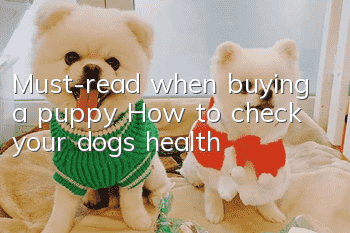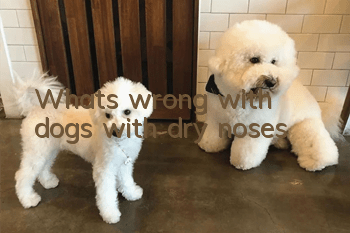Must-read when buying a puppy: How to check your dog’s health

When selecting a puppy, you can determine the dog’s health status by checking the dog’s facial features, senses, fur, excrement, and exercise ability. A healthy mental outlook of a puppy includes being lively and active, curious about moving objects, and having a desire to explore, etc. However, it also allows for fearful expressions when facing unknown objects, such as trembling, dodging, barking, etc. Being unresponsive to the outside world is not what a healthy puppy should be.
Check the dog’s facial features and secretions, including:
The skin condition inside your dog’s ears. The inside of a healthy dog's ear canal should be clean and warm. If you find that your dog's ears have a peculiar smell, are red, swollen, bleeding, or have unknown dark attachments, it means that there may be damage or parasites in the ears.
【Dog’s Mouth and Oral Conditions】
A healthy dog has white teeth, pink gums, no bad breath, and no other secretions except saliva. If you find odor, unknown secretions in your mouth, or pale gums or damaged teeth, it may be due to dietary problems, gum disease, malnutrition or even anemia.
【Touch the dog’s nose】
The nose of a healthy dog is slightly moist, and your fingers will feel wet after touching it (the nose of a dog that has just woken up will be dry). If there is nasal discharge, it should be clear and transparent. If you find that your dog's nose is dry or even cracked, or there is thick yellow mucus, it means that your dog's health is not optimistic. It may be a fever, or it may be a sign of respiratory disease. Nose color varies among different breeds and is not necessarily related to health status.
【Dog’s eyes】
For purebred dogs, different dog breeds have clear requirements for the shape, position, and iris color of their eyes, but this is not absolutely related to the dog's personality and health. When selecting a dog, pay attention to whether the dog's eyes are clean and whether they can be fully closed or opened. If you find that your eyes are bloodshot, there is flesh protruding from the corners of your eyes, or there is too much eye droppings, these are not good signs. In addition, some breeds, such as Chow Chow, are prone to inverted eyelashes or inverted eyelids, so please pay attention to check.
【Check the dog’s facial features】
By touching and slowly increasing the resistance of the dog's foot skin, check its resistance to external pressure. Dogs with stronger resistance will be more likely to accept being restrained by collars and leashes in the future.
Squeeze the sound toy behind the puppy and observe the puppy's performance. Generally, dogs will actively observe and look for the source of the sound, while timid dogs will show fear. But if the dog is completely unresponsive, you need to call a veterinarianCheck for possible hearing loss.
Use balloons or toys to shake in front of puppies. Dogs with normal vision will show curiosity, shift their sight along with the object, or show fear.
【Check the dog’s coat and skin condition】
The state of a dog’s coat is directly related to its diet and health. Regardless of the different coat feel of different breeds, a healthy dog's coat should look shiny, not messy, and not dry.
Use a needle comb with dense needle teeth to comb the dog's coat to check whether there is any dirt falling off. Unbalanced diet and nutrition or the use of inappropriate bath products will increase the amount of dandruff on the dog. Part your dog's coat and check the condition of the skin. The skin of a healthy dog is light pink with no obvious discoloration, and there should be no visible black spots at the hair roots (which may be parasites). Focus on checking the skin around the mouth, neck, abdomen, limbs, armpits, and anus to see if there are flakes or lumps of discoloration. If so, it may be a sign of fungal or mite infection.
【Check your dog’s excrement】
Excretion is the most direct reflection of the dog’s health. The excrement of a healthy dog should be soft and formed, mostly brown or yellow (the color of the feces has a lot to do with the ingredients). If you find that your dog's feces does not line up, becomes muddy, spherical, or even watery, or if you find that your dog's feces is red, gray-white, or black, it may be a sign of digestive tract disease or low immunity.
Checking whether the area around the dog’s anus is clean can also reveal the dog’s health. A healthy dog's anus should be clean, the skin should not be red or swollen, the coat around the anus should not be dry, and there should be no fecal residue. If you find that the hair around the anus is stained with feces, your dog may have diarrhea.
【Check the dog's athletic ability】
Let the dog walk and run on flat ground to check the coordination of its limbs. For a period of time after the puppies are born, their muscles and bones are not fully developed, and it is normal for them to be unbalanced when walking or running. This state should no longer occur frequently when it is three months old. If the dog still has difficulty moving, limp, and falls easily at this time, it may be injured or brain damaged.
- How long does it take for dogs to be dewormed before all the worms are killed?
- Signs of depression in dogs, come and see if your dog has it
- What should you do when faced with "fungi + mites + inflammation"?
- Select competition-grade Husky puppies based on bone proportions
- Illustration of the correct ways and precautions to greet your dog
- Dogs have dandruff and hair loss
- What to do if Teddy can’t digest dog food
- Will the ancient shepherd dog recognize its owner?
- Does Corgi recognize its owner?
- Can a dog recover after being hit by a car and unable to stand on its hind legs?



